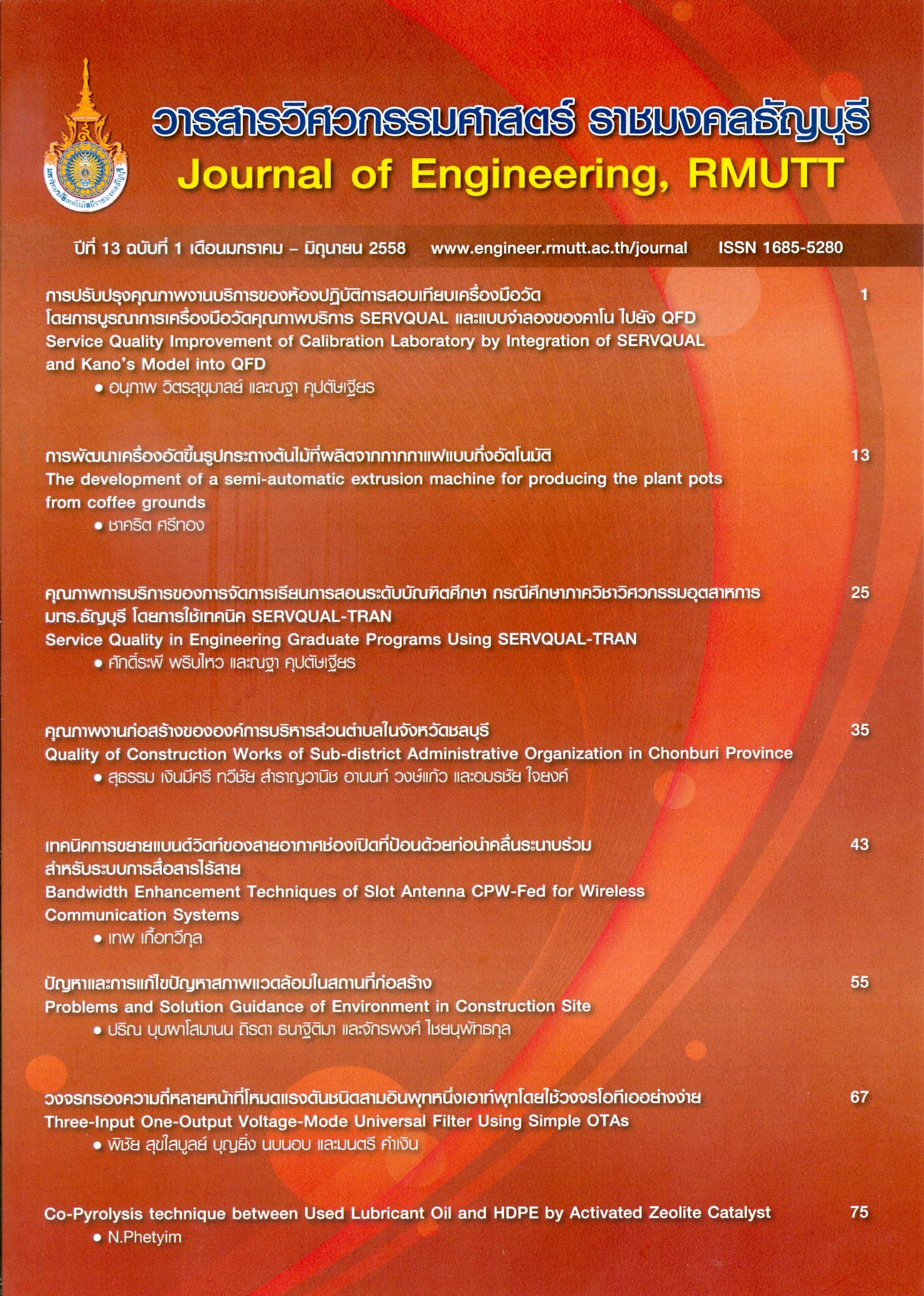Bandwidth Enhancement Techniques of Slot Antenna CPW-Fed for Wireless Communication Systems
Main Article Content
Abstract
In this paper presents bandwidth enhancement techniques of slot antenna CPW-Fed for wireless communication systems. Bandwidth enhancement techniques are composed of step slot antenna and insert strip in the slot antenna. This antenna is analyzed by using Finite Difference Time Domain (FDTD) method compared with MoM of IE3D software. Herein, slot antenna fed by CPW is analyzed for return loss (S11 parameter), input impedance (Zin), VSWR, density of current, magnetic field and electrical field, bandwidth and far field radiation patterns, respectively. Simulated results can be obtained resonance frequency and impedance bandwidth for four operating bands which cover the requirement in bandwidths of IEEE 802.11b/g (2.4-2.4835 GHz), IEEE 802.11j (4.9-5.0 GHz), IEEE 802.11a (5.150-5.350 GHz) and coverage WiMAX (2-6 GHz), and extended the slot antenna for UWB operation. The far-field radiation pattern of resonance frequencies is bi-directional.
Article Details
The manuscript, information, content, picture and so forth which were published on Frontiers in engineering innovation research has been a copyright of this journal only. There is not allow anyone or any organize to duplicate all content or some document for unethical publication.
References
Federal Communications Commission, 2002. “First Report and Order, Revision of Part 15 of the Commission’s Rules Regarding Ultra-Wideband Transmission Systems,” FCC.
C. A. Balanis, 2005. Antenna theory analysis and design, third editions, John Wiley & Son, Inc.
R. Garg, P. Bhartia, I. Bahl and A. Ittipiboon, 2001. Microstrip Antenna Handbook, Boston: Artech House.
I. J. Bahl, and P. Bharita, 1980. Microstrip Antenna, Dedham: Arthech House.
K. F. Lee and W. Chen, 1997. Advances in Microstrip and Printed Antennas, New York John Wiley & Sons, Inc.
W. Kueathaweekun, N. Anantrasirichai, J. Nakasuwan, and T. Wakabayashi, 2007. “Broadband Slot Antenna Fed by Microstrip Line”, ICEAST , 21-23 November, Thailand.
Y. Shih-Huang and W. Kin-Lu, 2002. “Dual-band F-Shaped Monopole Antenna for 2.4/5.2 GHz WLAN Application”, IEEE Antennas and Propagation Society International Symposium, vol. 4, Jun.
H. D. Chen, J. S. Chen, and Y. T. Cheng, 2007. “Modified Inverted-L Monopole Antenna for 2.4/5.2 GHz Dual-Band Operations,” Electron. Letter, Vol.39:1567-1568.
C. Horng-Dean, 2003. “Slot Antenna Coupled by Microstrip Line for Dual Frequency,” IEEE Trans. on Antennas and Propagation, Vol. 51, No. 8:1982-1986.
P. Jearapraditkul, W. Kueathaweekun, N. Anantrasirichai, O. Sangaroon and T.
Wakabayashi, “Bandwidth Enhancement of CPW–Fed Slot Antenna with Inset Tuning Stub”, ISCIT, 21-23 October, Vientiane, Lao.
W. Kueathaweekun, P. Jearapraditkul, N. Anantrasirichai, O. Sangaroon, and T.
Wakabayashi, 2008. “Wide-band CPW-fed Slot Antenna with Tuning Stub and π-Strip for WLAN/WiMAX Application”, ISPACS, 8-11 December, Bangkok, Thailand.
Zeland Software, Inc., IE3D, New York.
Yongxi Qian, Tatsuo Itoh, 1999. “FDTD Analysis and Design of Microwave Circuits and antennas Software and Applications”, Tokyo: Realize Inc.


